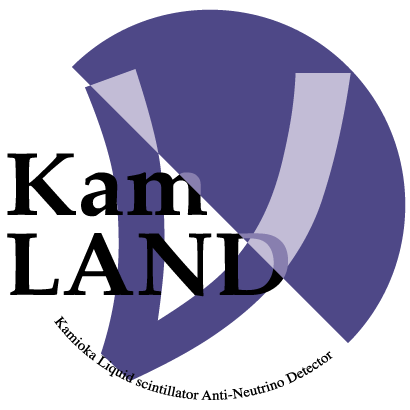Welcome to KamLAND... Particle Physics, Astrophysics, Geophysics |

|
Welcome to KamLAND... Particle Physics, Astrophysics, Geophysics |

|
The KamLAND experiment has substantially added our ability to study neutrinos, making possible a number of unique new measurements while improving many others. The detector consists of 1,000 tons of liquid scintillator housed in the old Kamiokande cavern. The availability of the Kamiokande site made possible the construction of a very ambitious detector at a comparatively modest cost since there was little civil engineering required.
The use of liquid scintillator producing substantially more light than a Cerenkov radiator allows lower detection thresholds while, at the same time, gives good neutron detection efficiency, providing a clear signature for inverse-beta-decay anti-neutrino capture. The clear signature of anti-neutrinos, together with the capability of obtaining equally clear signals for neutrino scattering on carbon, allows KamLAND to do first-rate science using currently available technology and liquid scintillator purification levels. Furthermore the detector design follows a very attractive ``scalable'' approach in that KamLAND could become one of the best detectors for studying solar neutrino physics with essentially no modifications once the purification technology for scintillators will reach the levels needed for this purpose.
The detector has conducted a study on electron anti-neutrinos from nuclear reactors. The presence of many large nuclear reactors in the 140 to 210~km range makes it ideally suited to study anti nue - anti nuX oscillations with an extremely long baseline. KamLAND has shown a anti-neutrino deficit as well as anti-neutrino energy spectral distortion, suggesting the existence of neutrino oscillations.
An investigation of anti-neutrinos from beta-decays inside the Earth conducted for the first time may provide useful geophysical information, while the anti-neutrino and flavor identification capabilities of KamLAND will substantially add, from the beginning of running, to the field of supernova neutrinos. Measurements of specific channels for nucleon decay and atmospheric neutrinos will also be carried-out.
The experience in running the detector gained in this first period, together with the new technological advances gained in dealing with ultra-pure materials, will subsequently allow us to move in the most effective way to a new phase when solar neutrino spectroscopy with low threshold will represent the first priority.
KamLAND belongs to a new generation of low-background detectors generally built to study particle physics and astrophysics. All these experiments derive from the realization that a great wealth of fundamental science can be done in a very cost effective manner by studying naturally produced cosmic radiation.
A few points, however, set KamLAND in a very special category of projects. First, this experiment is not only observing natural phenomena but, in fact, has been focusing on a laboratory style experiment, using neutrinos produced in reactors. No other experiment has access to this physics. Second, KamLAND represents a new qualitative step in obtaining detailed low energy information from an unprecedented mass of material. In this respect our detector has several times the mass of Borexino, and it therefore has access to a number of phenomena (like supernova neutrinos) that will produce marginal rates in other experiments. Finally, our detector is conceived in a unique scalable architecture that allows us to perform exciting measurements while improving the detector for future measurements. This allowed us to propose a detector that will eventually rely on technology of the future but needed virtually no time for R&D before obtaining the first physics results.

|
A review of Reactor-based Neutrino Oscillation Experiments |

|
The proposal for US involvement in KamLAND |

|
A paper we recently published entitled "Nuclear Propelled Vessels and Neutrino Oscillation Experiments" |